AUDI A7 2017 Owner´s Manual
Manufacturer: AUDI, Model Year: 2017, Model line: A7, Model: AUDI A7 2017Pages: 284, PDF Size: 72.29 MB
Page 221 of 284

a)
a)
.--< N ,-.. N ..... 0 a) 0.:,
"'
circumference as the regular
tires .
8,_ WARNING , -
-Only use tire/rim combina-
tions and suitable wheel bolts
that have been approved by
Audi. Otherwise, damage to
the vehicle and an accident
could result.
-For technical reasons, it is not possible to use tires from oth
er vehicles -in some cases,
you cannot even use tires from
the same vehicle model.
-Make sure that the tires you select have enough clearance
to the vehicle. Replacement
tires should not be chosen simply based on the nominal
size, because tires with a dif
ferent construction can differ greatly even if they are the
same size. If there is not
enough clearance, the tires or
the vehicle can be damaged
and this can reduce driving
safety and increase the risk of
an accident.
-Only use tires that are more
than six years old when abso
lutely necessary and drive
carefully when doing so.
Wheels
-Do not use run-flat tires on
your vehicle. Using them when
not permitted can lead to ve hicle damage or accidents.
-If you install wheel covers on
the vehicle, make sure they al
low enough air circulation to
cool the brake system. If they
do not, this could increase the
risk of an accident.
Tire wear/damage
Fig. 191 Tire profile: treadwear indica
tor
Tire wear
Check the tires regularly for wear .
-Inflation pressure that is too low
or high can increase tire wear
considerably.
-Driving quickly through curves, rapid acceleration and heavy
braking increase tire wear .
-Have an authorized Audi dealer
or authorized Audi Service Facili
ty check the wheel alignment if
there is unusual wear. ..
219
Page 222 of 284
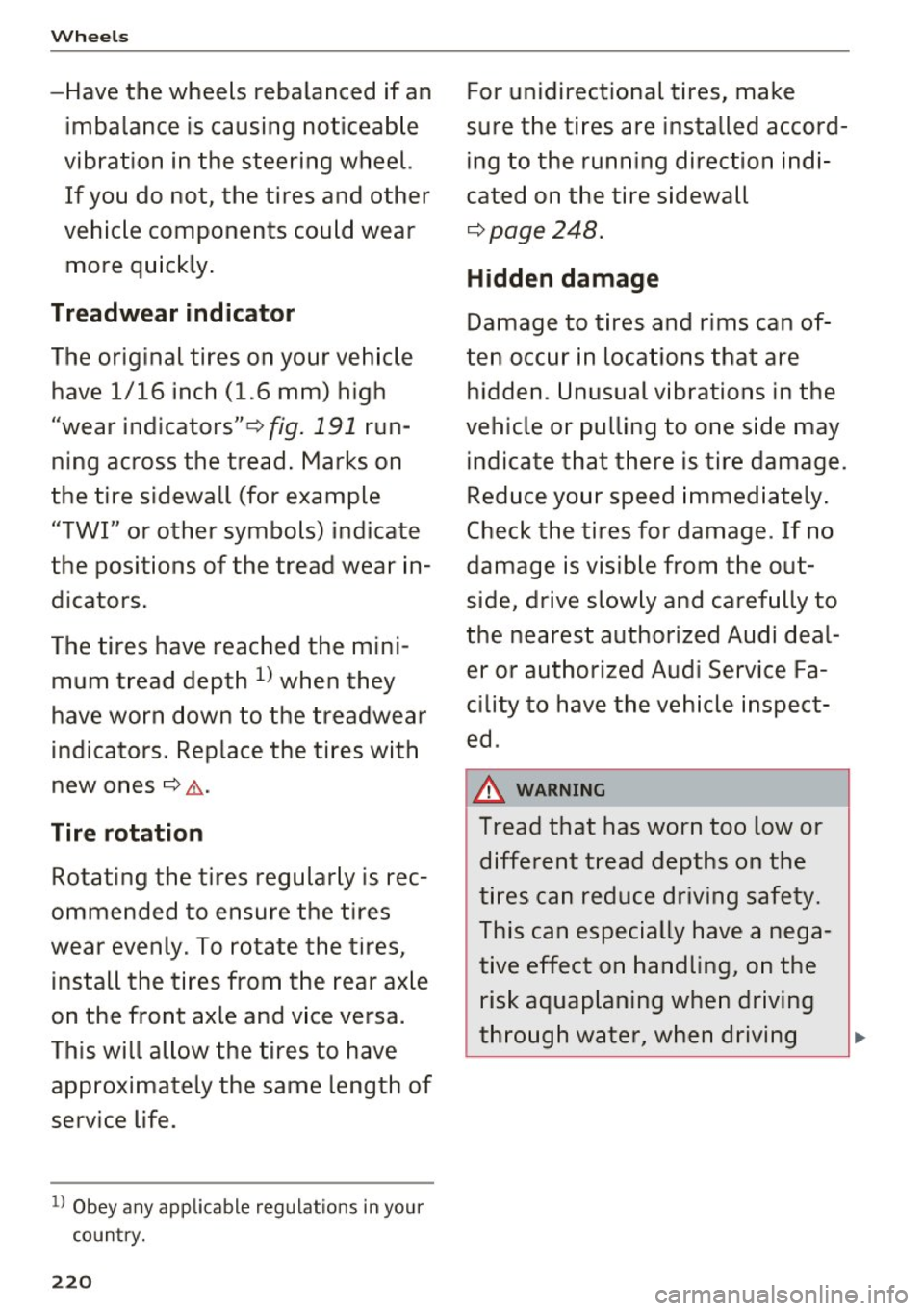
Wheels
-Have the wheels rebalanced if an imbalance is causing noticeable
vibration in the steering wheel. If you do not, the tires and other
vehicle components could wear
more quickly.
Treadwear indicator
The original tires on your vehicle have 1/16 inch (1 .6 mm) high
"wear indicators" ¢fig.
191 run
ning across the tread. Marks on
the tire sidewall (for example
"TWI" or other symbols) indicate
the positions of the tread wear in
dicators.
The tires have reached the mini
mum tread depth
l) when they
have worn down to the treadwear
indicators. Replace the tires with
new ones¢ .&..
Tire rotation
Rotating the tires regularly is rec
ommended to ensure the tires
wear evenly . To rotate the tires,
install the tires from the rear axle
on the front axle and vice versa.
This will allow the tires to have approximately the same length of
service life.
1> Obey any applicable regulations in your
country.
220
For unidirectional tires, make
sure the tires are installed accord
ing to the running direction indi
cated on the tire sidewall
¢page 248.
Hidden damage
Damage to tires and rims can of
ten occur in locations that are hidden . Unusual vibrations in the
vehicle or pulling to one side may indicate that there is tire damage.
Reduce your speed immediately.
Check the tires for damage . If no
damage is visible from the out
side, drive slowly and carefully to
the nearest authorized Audi deal
er or authorized Audi Service Fa
cility to have the vehicle inspect
ed .
&_ WARNING ~ -
Tread that has worn too low or
different tread depths on the
tires can reduce driving safety.
This can especially have a nega
tive effect on handling, on the risk aquaplaning when driving
through water, when driving .,.
Page 223 of 284
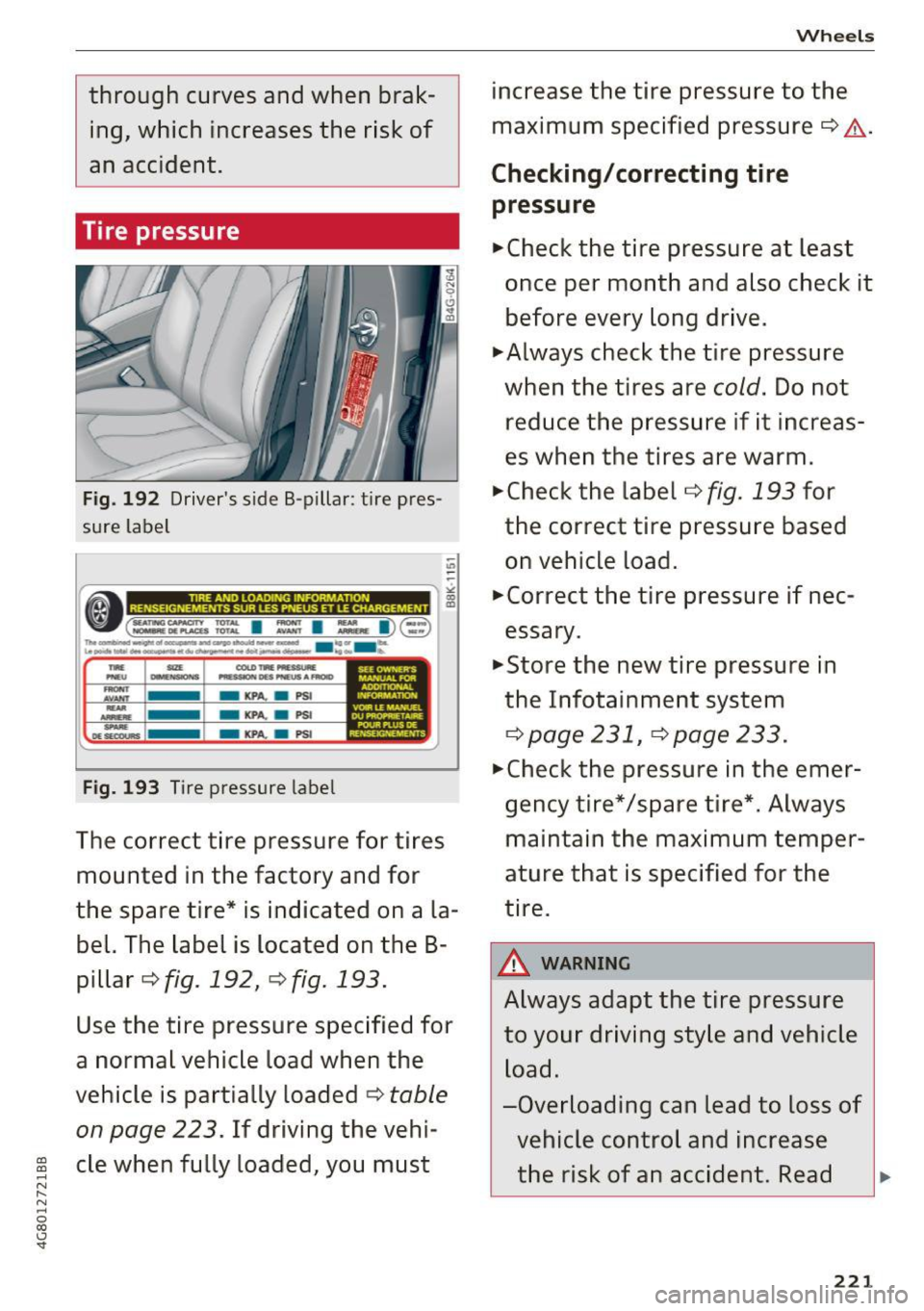
through curves and when braking, which increases the risk of
an accident.
Tire pressure
Fig. 192 Driver's side B-pillar : tire pres
sure label
"' -
-~-------------------,£
tM£. IIZl COLO tlllf fllllESSt.lW. PNfU Nl:4fN$IOM$ "IIISaoN OE$ PMEU$ A FROID
-AYIJff -KPA, a PSI
Fig. 193 Tire pressure label
The correct tire pressure for tires
mounted in the factory and for
the spare tire* is indicated on a la
bel. The label is located on the B
pillar ¢
fig. 192, ¢ fig. 193.
Use the tire pressure specified for
a normal vehicle load when the
vehicle is partially loaded¢
table
on page 223.
If driving the vehi-
; cle when fully loaded, you must
N
" N ... 0 CX) I..J st
Wheels
increase the tire pressure to the
maximum specified pressure¢&.-
Checking/correcting tire
pressure
.,,.Check the tire pressure at least
once per month and also check it before every long drive .
.,,.Always check the tire pressure
when the tires are
cold. Do not
reduce the pressure if it increas
es when the tires are warm .
... check the label ¢
fig. 193 for
the correct tire pressure based on vehicle load.
.,,.Correct the tire pressure if nec
essary.
... Store the new tire pressure in
the Infotainment system
¢page 231, ¢page 233 .
.,,.Check the pressure in the emer
gency tire* /spare tire*. Always maintain the maximum temper
ature that is specified for the
tire.
A WARNING
Always adapt the tire pressure to your driving style and vehicle load.
-Overloading can lead to loss of vehicle control and increase
the risk of an accident. Read
221
Page 224 of 284
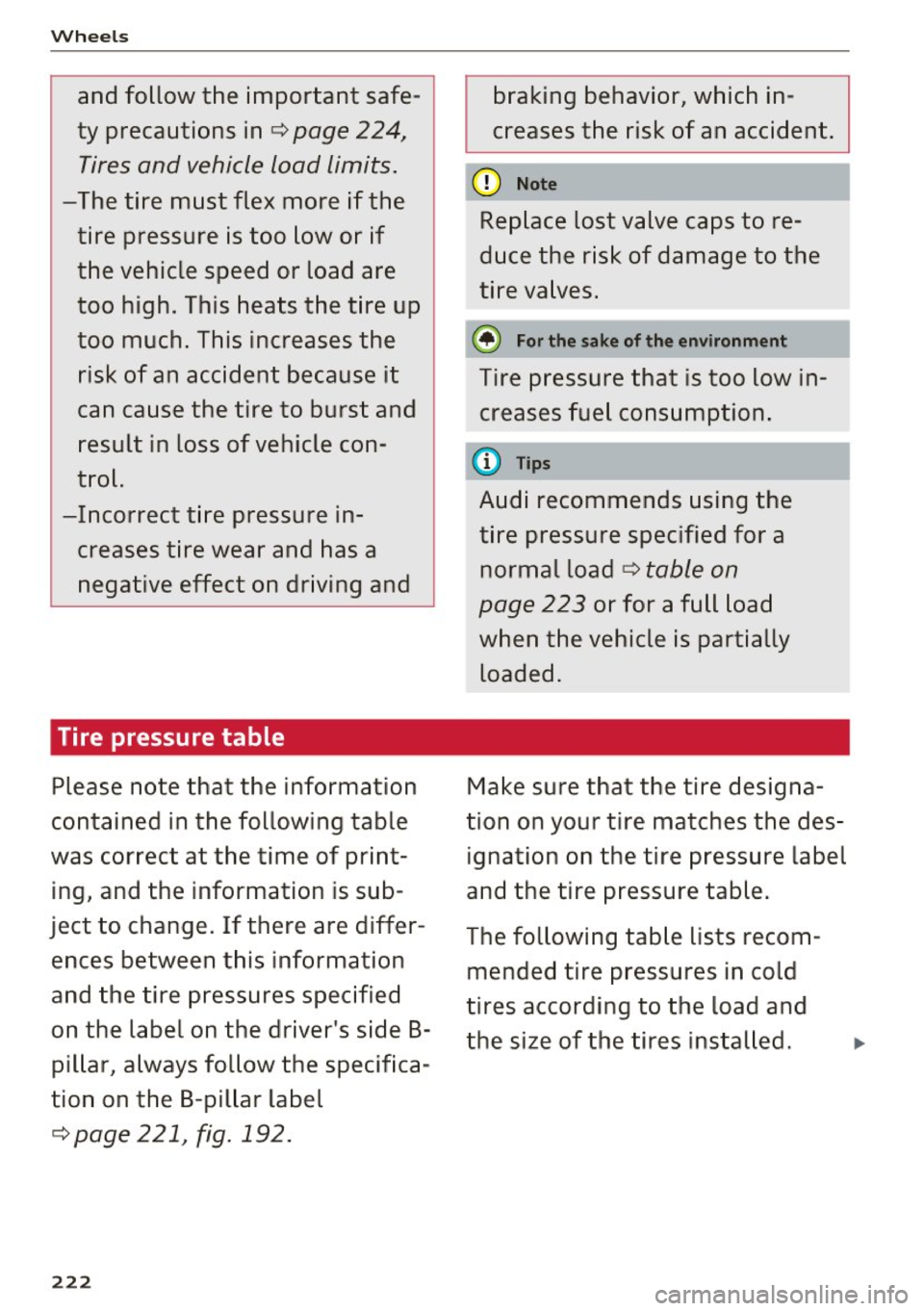
Wheels
and follow the important safe
ty precautions in
q page 224,
Tires and vehicle load limits.
-The tire must flex more if the
tire pressure is too low or if
the vehicle speed or load are
too high. This heats the tire up
too much. This increases the
risk of an accident because it
can cause the tire to burst and
result in loss of vehicle con
trol.
-Incorrect tire pressure in
creases tire wear and has a
negative effect on driving and
Tire pressure table
Please note that the information
contained in the following table
was correct at the time of print ing, and the information is sub
ject to change. If there are differ
ences between this information
and the tire pressures specified
on the label on the driver's side B
pillar, always follow the specifica
tion on the B-pillar label
q page 221, fig. 192.
222
braking behavior, which in
creases the risk of an accident.
(D Note
Replace lost valve caps to re
duce the risk of damage to the
tire valves.
@ For the sake of the environment
Tire pressure that is too low in
creases fuel consumption.
(D Tips
Audi recommends using the
tire pressure specified for a
normal load
q table on
page 223
or for a full load
when the vehicle is partially
loaded.
Make sure that the tire designa
tion on your tire matches the des
ignation on the tire pressure label
and the tire pressure table.
The following table lists recom
mended tire pressures in cold
tires according to the load and
the size of the tires installed.
Page 225 of 284

co
co
.... N
" N .... 0
00
\.J '
Engine
A7 :
3.0L
6 cylinder s
57:
4.0L 8 cylinders Tire designation
235 /55 R17 99Y
High Performance
255 /45 R18 99H
All Season
255/45 R18 99Y
High Perfo rmance
255 /40 R19 l00H
All Season
255 /40 R19 l00Y
High Performance
265/35 R20 99H
All Season
265 /35 R20 99Y
High Performance
275/30 R21 98 Y
High Performance
265/35 R20 99Y
High Performance
255/40 R19 l00Y
High Performance
275/30 R21 98Y
High Performance
Wheels
Tire pressure
Normal load Maximum load
(up to 2 /3* people )a>
front rear front rear
PSI kPA PSI kPA PSI kPA PSI kPA
32 220 29 200 35
240
38 260
32 220 29 2 00 35 240
38 260
32 220 29 200 35 240 38 260
35 240
32 220 38 260 41
280
36 250 32 220 38 260 41
280
35 2 40 32 220
38 260 41 280
36 250 32 220 38 260 41
280
38 260 33 230
39 270
41 280
41 280
35 2
4 0 44
300 44
300
39 270 33 2 30 42 290 42 290
41 280 35 240 44
300 44
300
223
Page 226 of 284
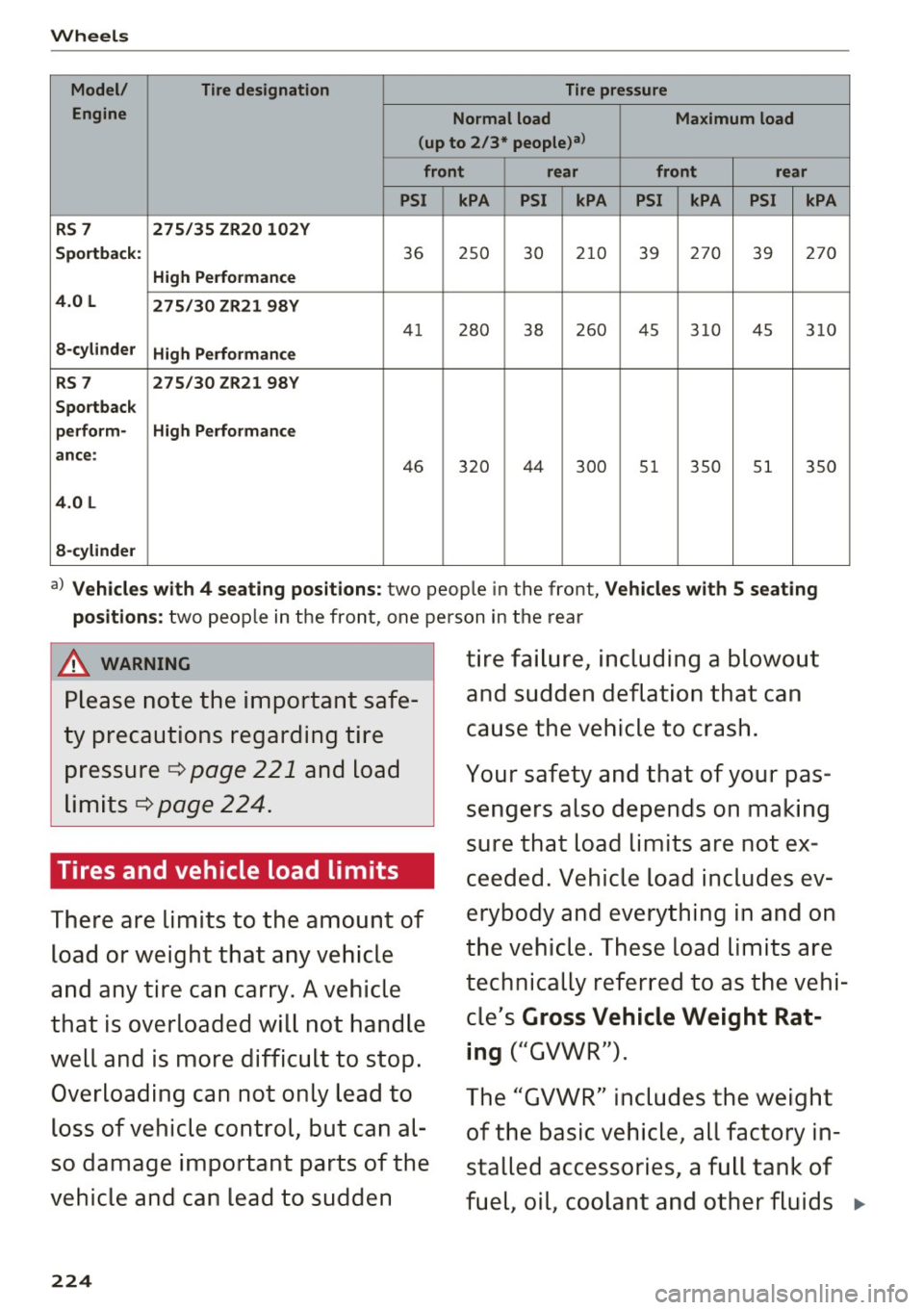
Wheels
Model/ Tire designation Tire pressure
Engine Normal load Maximum load
(up to 2/3* people)a>
front rear front rear
PSI kPA PSI kPA
PSI kPA PSI kPA
RS 7 275/35 ZR20 102Y
Sportback:
36 250 30 210 39 270
39 270
High Performance
4.0 L 275/30 ZR21 98Y
41 280 38 260 45 3 10 4 5 310
8-cylinder
High Performance
RS 7 275/30 ZR21 98Y
Sportback
perform- High Performance
ance:
46 320 44
300 51 350 51 350
4.0 L
8-cylinder
a) Vehicles with 4 seating positions: t wo people i n the front, Vehicles with 5 seating
positions:
two peop le in t he front , one pe rson in the re ar
A WARNING
Please note the important safe
ty precautions regarding tire pressure ¢
page 221 and load
limits¢
page 224.
Tires and vehicle load limits
There are limits to the amount of
load or weight that any vehicle
and any tire can carry. A vehicle
that is overloaded will not handle
well and is more difficult to stop.
Overloading can not only lead to
loss of vehicle control, but can al
so damage important parts of the
vehicle and can lead to sudden
224
tire failure, including a blowout
and sudden deflation that can
cause the vehicle to crash.
Your safety and that of your pas
sengers also depends on making
sure that load limits are not ex
ceeded. Vehicle load includes ev
erybody and everything in and on
the vehicle. These load limits are
technically referred to as the vehi
cle's
Gross Vehicle Weight Rat
ing
("GVWR").
The "GVWR" includes the weight
of the basic vehicle, all factory in
stalled accessories, a full tank of
fuel, oil, coolant and other fluids
111-
Page 227 of 284
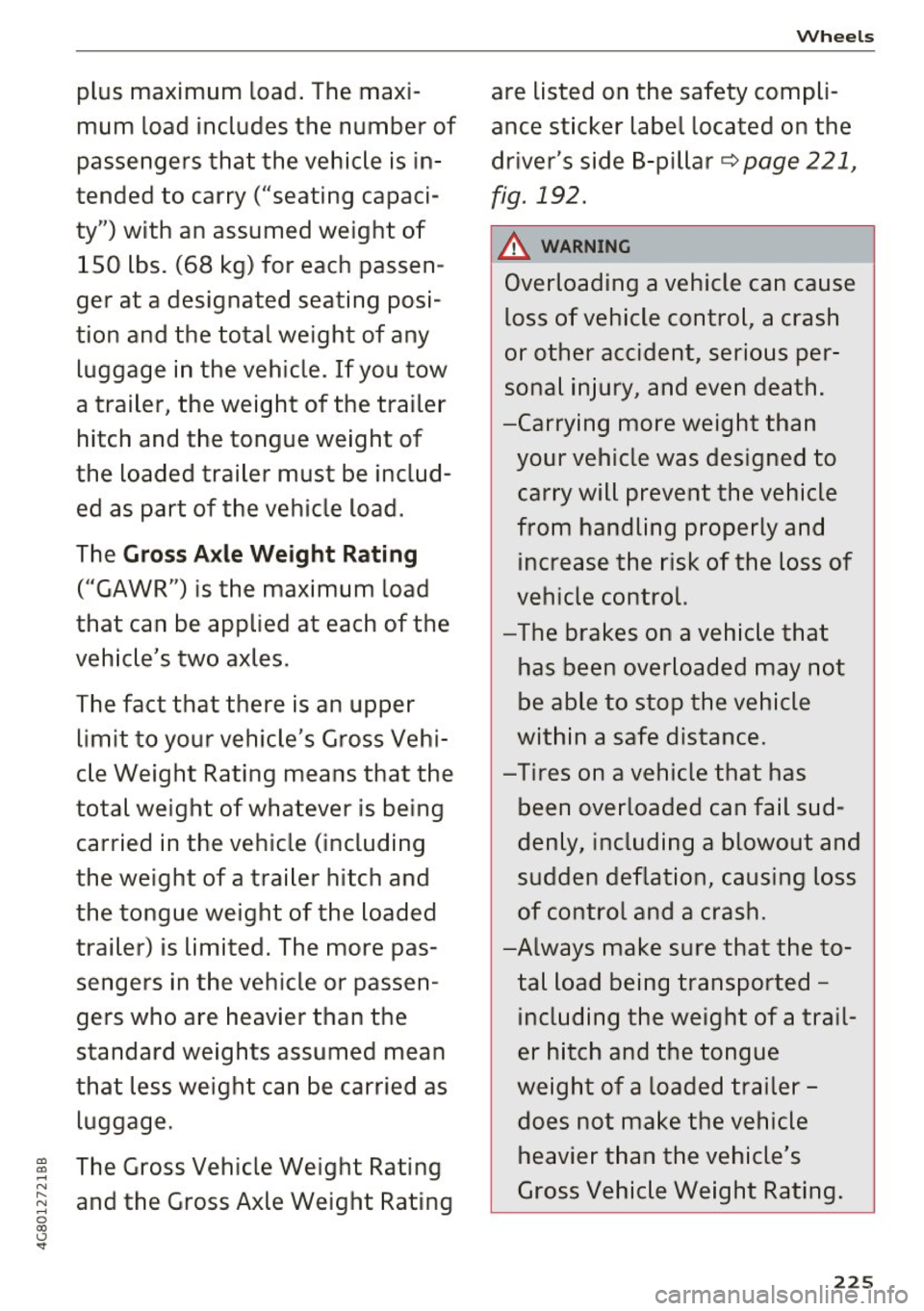
plus maximum load. The maxi
mum load includes the number of
passengers that the vehicle is in
tended to carry ("seating capaci
ty") with an assumed weight of
150 lbs. (68 kg) for each passen
ger at a designated seating posi
tion and the total weight of any luggage in the vehicle . If you tow
a trailer, the weight of the trailer
hitch and the tongue weight of
the loaded trailer must be includ
ed as part of the vehicle load .
The
Gross A xle Weight Rating
("GAWR") is the maximum load
that can be appl ied at each of the
vehicle's two axles.
The fact that there is an upper
limit to your vehicle's Gross Vehi
c le Weight Rating means that the
total weight of whatever is being
carried in the vehicle (including
the weight of a tra iler hitch and
the tongue weight of the loaded
trailer) is limited. The more pas
sengers in the vehicle or passen
gers who are heavier than the
standard weights assumed mean
that less weight can be carried as luggage.
; The Gross Vehicle We ight Rating
N
~ and the Gross Axle Weight Rating 0 co OJ ..
Wheels
are listed on the safety compli
ance sticker label located on the
driver's side B -pillar
¢ page 221,
fig . 192.
_& WAR NING
Overloading a vehicle can cause
loss of vehicle control, a crash
or other accident, serious per
sonal in jury, and even death.
-Carrying more weight than
your vehicle was designed to carry will prevent the vehicle
from handling properly and increase the risk of the loss of
vehicle control.
- The brakes on a vehicle that
has been overloaded may not
be able to stop the vehicle
within a safe distance.
-Tires on a vehicle that has
been overloaded can fail sud
denly, including a blowout and
sudden deflation, causing loss
of control and a crash.
-Always make sure that the to
tal load being transported -
including the weight of a trail
er hitch and the tongue
weight of a loaded trailer - does not make the vehicle
heavier than the vehicle's
Gross Vehicle Weight Rating .
225
Page 228 of 284

Wheels
Determining correct load
limit
Use the example below to calcu
late the total weight of the pas
sengers and luggage or other
things that you plan to transport so that you can make sure that
your vehicle will not be overload ed .
Steps for Determining Correct
Load Limit
1 . Locate the statement "THE
COMBINED WEIGHT OF OCCU PANTS AND CARGO SHOULD
NEVER EXCEED XXX KG OR XXX
LBS"on your vehicle 's placard
(tire inflation pre ssure label)
¢ page 221, fig. 192.
2. Determine the combined
weight of the driver and pas
sengers that will be riding in
your vehicle.
3 . Subtra ct the combined weight
of the driver and passengers
from
"XXX" kilograms or " XXX"
pounds shown on the sticker
¢ page 221 , fig. 192 .
4. The re sulting figure equals the
available amount of cargo and luggage load capacity. For ex
ample, if the
"XXX" amount
equals 1400 lbs. and there will
226
be five 150 lbs. passengers in
your vehicle, the amount of available cargo and luggage load capacity is 650 lb s.
(1400-750 (5 X 150) = 650
lb s.)
5. Determine the combined weight of luggage and cargo
being loaded on the vehicle.
That weight may not safely ex
ceed the available cargo and luggage load capacity calculat
ed in Step 4 .
6. If your vehicle will be towing a trailer, load from your trailer
will be transferred to your ve
hicle. Con sult this manual to
determine how this reduces
the available cargo and lug gage load capacity of your vehi
cle .
~check the tire sidewall
(¢ page 211, fig. 190) to deter
mine the designated load rating
for a specific tire.
· Wheel bolts and rims
Wheel bolts
W heel bolts mus t be clean and loose n/tighten
eas ily.
Rims
R ims with a bo lted r im ring * or with bo lted wheel
covers" co nsist of mult ip le p ieces . T h ese compo-
n ents were bolted togethe r usin g s pec ial bolts ..,.
Page 229 of 284

co
co
.... N
" N .... 0
00
\.J '
disassemble them ¢.&. .
A WARNING
Wheel bolts that are tightened or repaired in
correctly can become loose and result in loss
of vehicle control, which increases the risk of
an acc ident. For the correct tightening specifi
cation, see ¢
page 244, After changing a
wheel .
- Always keep the wheel bolts and the
threads in the wheel hub clean and free of grease.
- Only use wheel bolts that fit the rim .
- Always have damaged r ims repa ired by an
authorized Audi dealer o r autho rized Aud i
Service Facility . Never repair or d isassemble
rims yourself, because this increases the risk
of an accident.
Winter tires
W inte r ti res s ignificantly improve the vehicle's
h andling when driving in win ter condit ions . Be
cause of the ir constr uction (width, compound,
tread pattern), summer tires provide less trac
tion on ice and snow .
... Use w inter t ires on all fo ur wheels .
... Only use winter t ires that are approve d for your
v ehicl e.
... Please note that the maximum permitted
speed may be lower with winter tires¢.&_ . An
authorized Aud i dealer or au thori zed Aud i Serv
ice Fac ility can inform you about the maximum
permitted speed fo r your tires .
... Check the tire press ure after installing wheels
¢page 221.
The effectiveness of winter tires is reduced great
l y when the tread is worn down to a depth of
0 .1 57 in ( 4 mm). The character ist ics of winter
tires a lso de crease great ly as the tire ages, re
ga rdless of the remain ing tread.
WARNING
- Never drive faster than the maxim um per
mitted speed for your t ires. This cou ld cause
the tires to heat up too much. Th is increases
Wh eel s
the risk of an accident because it can cause
the t ire to burst.
- Always adapt your driving to the road and
traffic cond itions . Drive carefully and reduce
your speed on icy or slippery roads . Even
winter t ires can lose tract io n on black ice.
@ For the sake of the environment
Reinsta ll summer tires at the app ropr iate
time, beca use they prov ide better handling
when roads are free of snow and ice. Summer
tires cause less road no ise, tire wear and fue l
consumpt io n.
(D Tips
You can also use all season tires instead of
winter tires. Please note that in some coun
tries where winter tires are required, on ly
winter tires w ith the
& symbo l may be per
mitted .
Snow chains
Snow ch ains not o nly improve t he d riv in g in win
te r road condit ions, bu t also the braking .
... On ly install snow cha ins on the fron t wheels .
Th is applies a lso to vehicles with a ll w heel
drive * .
... Check and correct the se ating of the snow
chai ns after driving a few feet, if necessary . Fol
low th e instructions from the manufacturer.
... Note the maximum speed of 30 mph (SO km/
h). Note the local regula tions .
U se of snow cha ins is only permitted with certa in
rim/tire combinat ions due to technical reasons .
Check with an autho riz ed Audi dealer or author
i z ed Audi Service Facility to see if you may use
snow c hains .
Yo u m ust remove the snow chains on roads with
o ut snow . Otherw ise, you co uld impai r dr iving
ability and damage the t ires .
A WARNING ,_
Using incor rect snow chains or installing snow
cha ins incor rectly can resu lt in loss of veh icle
~
227
Page 230 of 284

Wheels
co ntrol, w hich inc reases t he risk of an
accident .
(D Note
-Snow cha ins can damage the rims/whee l
covers * if the chains come into d irect con
tact with them. Remove the whee l cove rs *
first. Use coated snow chains.
- Usin g sn ow chains that a dd more than 0 .4
i nch (10.5 mm) of he ight can severely dam
age the wheel ho usings and other vehicle
components .
- Do not install and use snow chains if there is
a malfunct ion in the adaptive air suspen
s io n*, because the vehicle height wi ll be
very low . If yo u drive with snow chains any
way, the wheel ho usings a nd othe r vehicle
co mp onen ts ca n be severe ly da mage d.
(D Tips
When using snow cha ins, it may b e usef ul to
sw itch on spo rt mo de
~ pag e 12 1.
Low aspect ratio tires
Your Aud i is f actory-equipped wi th low aspec t ra
t io tires. The se tir es h ave bee n thor oughly te sted
and b een se lected s pecific ally fo r yo ur model fo r
their superb perfo rmance , road feel and hand ling
un der a va riety of driving conditions. As k yo ur au
thor ized Audi dealer for mo re details .
Th e low aspect ratio of these tires is indi cate d by
a nume ra l of
55 or less in t he tire's size desig na
tion. The nume ra l r ep resents the rat io of t he
tire's sidewall he ight i n relat ion to its tread wi dth
expressed in pe rcentage. Conventional tires have
a heig ht/w idt h rat io o f 60 o r mo re.
The performance of low-aspect-ratio tires is par
ticularly sensitive to improper inflation pres
sure. It is therefore important that low aspect
ratio tires are inflated to the specified pressure
and that the inflation pressure is regularly
checked and maintained. Tire pressures should
be checked at least once a month and always
before a long trip~
page 221.
228
What you can do to avoid tire and rim
damage
Low aspect ratio tires can be damaged more eas i
l y by impact with potho les, curbs, gullies or
r idges on the road, particularly if the tire is un
der inflated.
In orde r to mi nimize the occurrence of impact
damage to the tires o f yo ur vehicle, we recom
mend that you observe the following preca u
tions:
- Always maintain recommended inflation pres
sures. Check yo ur tire pressure every 2,000
m iles (3,000 km) and add a ir if necessary.
- Dr ive carefully on roa ds w it h potholes, deep
gullies o r ridges. The impact from dr iv ing
throug h or over such obstacles can damage
your t ires. Impac t with a curb may a lso ca use
damage to yo ur tir es.
- After a ny impact, immed iate ly inspect you r
tires or have them inspected by the nearest au
t horize d Aud i dealer . Replace a damage d tire as
soo n as poss ible .
- Inspec t your tir es ev ery 2,000 m iles (3,000 km)
for d amage and wear . Damage is no t always
easy to see . Da mage ca n lead to loss o f air and
un derinfla tion, w hich could eve ntually ca use
t ire f ailure. If yo u be lieve th at a tir e m ay h ave
been dam age d, rep la ce the tire as soon as pos
sible .
- These tire s may wea r mo re quick ly th an ot hers.
- Ple ase also remember th at , while t hese tires
delive r respo nsive h andli ng, they may rid e less
c omforta bly an d make mo re noise than o ther
choices .
Reduced performance in winter/cold season
conditions
A ll t ires are des igned for certain purposes . T he
l ow aspect ratio, ultra h igh performance tires
o rigina lly installed on your veh icle are inten ded
fo r max imum d ry and wet road per formance and
h andling . They a re not suitable fo r co ld, snowy or
i cy weather conditions . If yo u drive under those
c ir cums tances, you should eq uip yo ur vehicle
wi th all-season o r winter tires, which offer be tter
t ra ct io n und er th ose condi tions. We suggest yo u ..,.